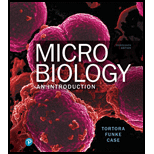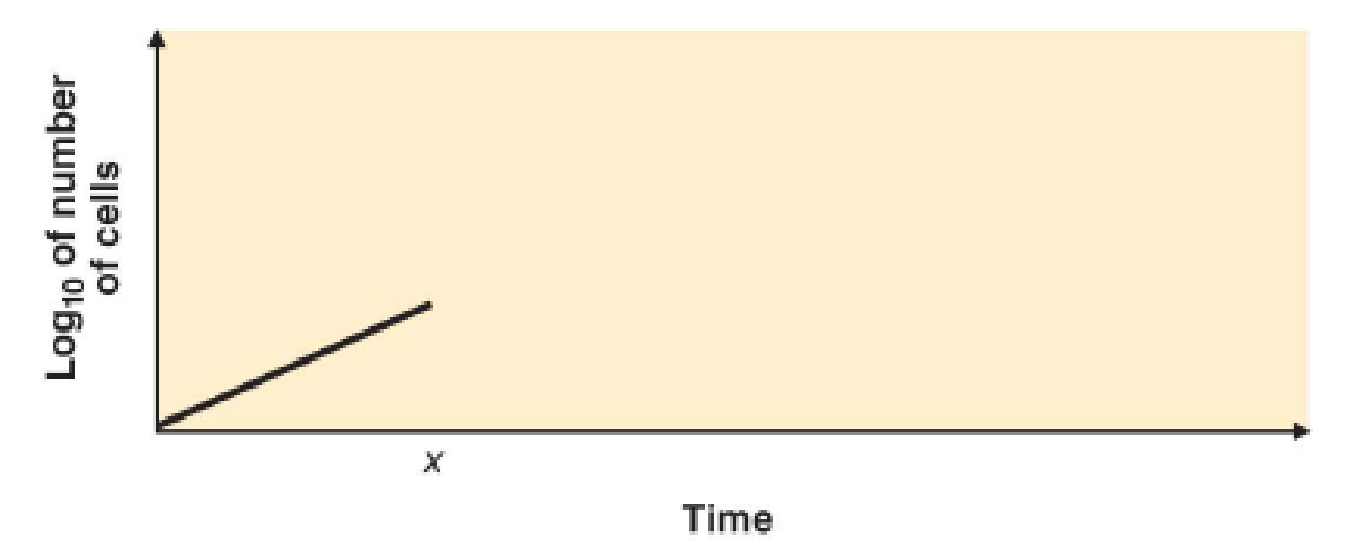
Microbiology: An Introduction (13th Edition)
13th Edition
ISBN: 9780134605180
Author: Gerard J. Tortora, Berdell R. Funke, Christine L. Case, Derek Weber, Warner Bair
Publisher: PEARSON
expand_more
expand_more
format_list_bulleted
Concept explainers
Textbook Question
Chapter 7, Problem 5R
DRAW IT A bacterial culture was in log phase in the following figure. At time x, an antibacterial compound was added to the culture. Draw the lines indicating addition of a bactericidal compound and a bacteriostatic compound. Explain why the viable count does not immediately drop to zero at x.

Expert Solution & Answer
Want to see the full answer?
Check out a sample textbook solution
Students have asked these similar questions
A culture of E. coli has a concentration of 5 x 108cells/mL. How many times do you have todilute the culture so that when you spread 0.1mL on an agar plate you will have 250 colonies?Hint: you need to find dtotal and then convert it into a DF.
A new chemical disinfectant was tested for activity against Staphylococcus growth. The bacteria were incubated in bacterial growth medium + disinfectant for 24 hours, then one loopful of the mixture was transferred to fresh medium without the disinfectant (subculturing) and incubating the subculture. The initial culture and subcultures were evaluated for growth after incubation. (+ = growth; - = no growth)
Dilution
Initial
Subculture
1:2
-
-
1:4
-
-
1:8
-
+
1:16
+
+
1:32
+
+
Based on these results, which of the following statements is true regarding the effectiveness of this disinfectant against this bacterium?
The disinfectant is bacteriostatic at 1:4 dilution.
The disinfectant is bacteriostatic at 1:2 dilution.
The disinfectant is NOT bacteriostatic at any of the dilutions tested.
The disinfectant is bacteriostatic at 1:8 dilution.
The disinfectant is bacteriostatic at 1:16 dilution.
Given the illustration and values below, determine the concentration of the original sample. Report results in CFU/mL or colony-forming unit/milliliter. Note that in order to observe the accuracy of results, culture plates with countable colonies between 25-250 CFU are considered in standard bacterial plate count.
Chapter 7 Solutions
Microbiology: An Introduction (13th Edition)
Ch. 7 - The thermal death time for a suspension of...Ch. 7 - If pasteurization does not achieve sterilization,...Ch. 7 - Thermal death point is not considered an accurate...Ch. 7 - Prob. 4RCh. 7 - DRAW IT A bacterial culture was in log phase in...Ch. 7 - How do autoclaving, hot air, and pasteurization...Ch. 7 - How do salts and sugars preserve foods? Why are...Ch. 7 - Prob. 8RCh. 7 - A large hospital washes burn patients in a...Ch. 7 - Prob. 10R
Ch. 7 - Which of the following does not kill endospores?...Ch. 7 - Which of the following is most effective for...Ch. 7 - Prob. 3MCQCh. 7 - Which of the following cannot be used to sterilize...Ch. 7 - Prob. 5MCQCh. 7 - The data were obtained from a use-dilution test...Ch. 7 - The data were obtained from a use-dilution test...Ch. 7 - Prob. 8MCQCh. 7 - A classmate is trying to determine how a...Ch. 7 - Which of the following is most likely to be...Ch. 7 - Prob. 1ACh. 7 - For each of the following bacteria, explain why it...Ch. 7 - A use-dilution test was used to evaluate two...Ch. 7 - To determine the lethal action of microwave...Ch. 7 - Entamoeba histolytica and Giardia lamblia were...Ch. 7 - Between March 9 and April 12five chronic...Ch. 7 - Prob. 3CAE
Additional Science Textbook Solutions
Find more solutions based on key concepts
Figure 1.18 In the example below, the scientific method is used to solve an everyday problem. Which part in the...
Concepts of Biology
2. Why is it that the range of resting blood pressures of humans is best represented by a bell-shaped curve co...
Human Biology: Concepts and Current Issues
11. In the early 1800s, French naturalist Jean Baptiste Lamarck suggested that the best explanation for the rel...
Campbell Biology: Concepts & Connections (9th Edition)
a. What three lineages of lobe-fins survive today? b. Go back to the phylogenetic tree in Interactive Question ...
Study Guide for Campbell Biology
What are the cervical and lumbar enlargements?
Principles of Anatomy and Physiology
Knowledge Booster
Learn more about
Need a deep-dive on the concept behind this application? Look no further. Learn more about this topic, biology and related others by exploring similar questions and additional content below.Similar questions
- You are given a 1 gram soil sample of unknown bacterial load. After doing 10-fold serial dilutions of the soil in sterile water, 100 uL volumes are taken from each dilution for preparation of pour plates. Following incubation, each half of the 10-8 plate has 46 colonies.a) What was the dilution factor?b) How many bacteria were present in the soil?2. Staphylococcus aureus divides every 20 minutes. A culture begins with 10 bacterial cells.a) After 5 hours, how many generations have occurredb) After 5 hours, how many bacteria are present?3. How many milliliters would you need to prepare a 10-2 dilution from a 10ml starting culture?arrow_forwardUsing one of the graphs obtained with the medium II, name the different phases of the bacterial growth and indicate the starting and ending time points of these phases as well as the physiological characteristics of the bacteria during each phasearrow_forwardIn a bacterial culture on an agar plate, what is a zone of inhibition? An area where the growth of bacteria is increased compared to the rest of the agar plate An area where the growth of bacteria is prevented or reduced compared to the rest of the agar plate An area where the growth of bacteria is not affected compared to the rest of the agar plate An area where the the agar becomes contaminated with moldarrow_forward
- The figure attached shows the colonies on Eosin Methylene Blue Agar (EMBA) plate. Make a description on the picture.arrow_forwardDescribe characteristics of Streptococcus Agalactiae in the Agar: (How does colonies look like (color) and explain does it grow on that agar. (Don't have to write the incubation period) ~ Only describe how would it look like on the Agar: Blood Agar (Aerobic) MacConkey EMB PEA Mannitol Salt Agar Chocolate Agar Nutrient Agararrow_forwardA pure culture was inoculated onto a Mueller-Hinton agar plate. The Kirby-Bauer procedure was performed. One of the drugs tested showed a large zone of inhibition but also had small colonies growing within this zone. Further testing showed that these colonies were not the results of contamination. Why would these colonies be present within this zone of inhibition?arrow_forward
- There are two cultures of yeast cells in the pictures, one has been incubated for 6 hours and one has been incubated for 24 hours. After a 10x dilution by taking 100µl of each culture and adding it to 900 µl water in a microcentrifuge tube and 100µl sample from the tube was taken to view in the counting chamber. a) Count the total number of yeast cells for each culture respectively b) Calculate the concentration and density of yeast cells for each culture respectivelyarrow_forwardMatch the description to the correct phase in a standard bacterial growth curve. best time to perform Gram stains [ Choose ] [Choose ] phase in which one would see the highest concentration of endopores lag phase stationary phase phase in which bacteria are most sensitive to log/exponential stage antibiotics death/decline phase many bacteria ih biofilms are in this phase, [Choose] thus are more resistant to antibiotics stage at which "carrying capacity" is reached [Choose ]arrow_forwardA serial dilution of a bacterial culture yields the following number of colonies. Which plate(s) should be used to determine the original cell density? Plate A Plate B Plate C Plate D Plate E Dilution Factor 10-5 10-6 10-7 10-8 10-9 # of Colonies Too many to count 850 456 80 14 Group of answer choices All of these choices A & B D & E E None of these choices A B & C D B C & D Carrow_forward
- Below are morphological, physiological and biochemical characteristics of an unknown luminous bacterium isolated from the gills of a marine fish. Use the data below to identify the isolate. Make an identification scheme Test Unknown Isolate B 1 Luminescence Positive 2 Cell Shape Straight Rods 3 Gram Staining Negative 4 Oxygen Requirement Facultative Anaerobe 5 Motility (Hanging Drop) Motile 6 Growth at 0% NaCl Negative 7 3% NaCl Positive 8 6 % NaCl Positive 9 Accumulation of PHB Positive 10 Flagella 1 Polar 11 Oxidase Positive 12 Nitrate Reduction 13 Gelatinase Negative 14 Growth at 35OC Positive 15 Growth at 4OC Negative 16 Methyl Red Positive 17 Voges-Proskauer Positive 18 Catalase Positive 19 Starch Hydrolysis Negative 20 Lysine…arrow_forwardA bacterium is inoculated into a medium containing two carbon sources, one of which is the bacterium’s preferred carbon source. The resulting growth curve shows two lag phases. Explain this phenomenon. What is this type of growth called? Include a diagram of what the growth curve would look like and indicate the usage of each carbon source.arrow_forwardYou are transferring a bacterial culture from a tube of broth to a Petri dish containing trypticase soy agar. Please list the steps that are necessary to make the transfer successfully and with minimal risk. of contamination.arrow_forward
arrow_back_ios
SEE MORE QUESTIONS
arrow_forward_ios
Recommended textbooks for you
 Human Anatomy & Physiology (11th Edition)BiologyISBN:9780134580999Author:Elaine N. Marieb, Katja N. HoehnPublisher:PEARSON
Human Anatomy & Physiology (11th Edition)BiologyISBN:9780134580999Author:Elaine N. Marieb, Katja N. HoehnPublisher:PEARSON Biology 2eBiologyISBN:9781947172517Author:Matthew Douglas, Jung Choi, Mary Ann ClarkPublisher:OpenStax
Biology 2eBiologyISBN:9781947172517Author:Matthew Douglas, Jung Choi, Mary Ann ClarkPublisher:OpenStax Anatomy & PhysiologyBiologyISBN:9781259398629Author:McKinley, Michael P., O'loughlin, Valerie Dean, Bidle, Theresa StouterPublisher:Mcgraw Hill Education,
Anatomy & PhysiologyBiologyISBN:9781259398629Author:McKinley, Michael P., O'loughlin, Valerie Dean, Bidle, Theresa StouterPublisher:Mcgraw Hill Education, Molecular Biology of the Cell (Sixth Edition)BiologyISBN:9780815344322Author:Bruce Alberts, Alexander D. Johnson, Julian Lewis, David Morgan, Martin Raff, Keith Roberts, Peter WalterPublisher:W. W. Norton & Company
Molecular Biology of the Cell (Sixth Edition)BiologyISBN:9780815344322Author:Bruce Alberts, Alexander D. Johnson, Julian Lewis, David Morgan, Martin Raff, Keith Roberts, Peter WalterPublisher:W. W. Norton & Company Laboratory Manual For Human Anatomy & PhysiologyBiologyISBN:9781260159363Author:Martin, Terry R., Prentice-craver, CynthiaPublisher:McGraw-Hill Publishing Co.
Laboratory Manual For Human Anatomy & PhysiologyBiologyISBN:9781260159363Author:Martin, Terry R., Prentice-craver, CynthiaPublisher:McGraw-Hill Publishing Co. Inquiry Into Life (16th Edition)BiologyISBN:9781260231700Author:Sylvia S. Mader, Michael WindelspechtPublisher:McGraw Hill Education
Inquiry Into Life (16th Edition)BiologyISBN:9781260231700Author:Sylvia S. Mader, Michael WindelspechtPublisher:McGraw Hill Education

Human Anatomy & Physiology (11th Edition)
Biology
ISBN:9780134580999
Author:Elaine N. Marieb, Katja N. Hoehn
Publisher:PEARSON

Biology 2e
Biology
ISBN:9781947172517
Author:Matthew Douglas, Jung Choi, Mary Ann Clark
Publisher:OpenStax

Anatomy & Physiology
Biology
ISBN:9781259398629
Author:McKinley, Michael P., O'loughlin, Valerie Dean, Bidle, Theresa Stouter
Publisher:Mcgraw Hill Education,

Molecular Biology of the Cell (Sixth Edition)
Biology
ISBN:9780815344322
Author:Bruce Alberts, Alexander D. Johnson, Julian Lewis, David Morgan, Martin Raff, Keith Roberts, Peter Walter
Publisher:W. W. Norton & Company

Laboratory Manual For Human Anatomy & Physiology
Biology
ISBN:9781260159363
Author:Martin, Terry R., Prentice-craver, Cynthia
Publisher:McGraw-Hill Publishing Co.

Inquiry Into Life (16th Edition)
Biology
ISBN:9781260231700
Author:Sylvia S. Mader, Michael Windelspecht
Publisher:McGraw Hill Education
Chapter 5 Microbial Metabolism; Author: Heather Davis;https://www.youtube.com/watch?v=wH_HrsfDWZw;License: Standard Youtube License